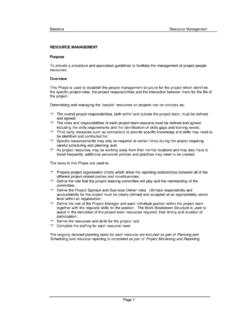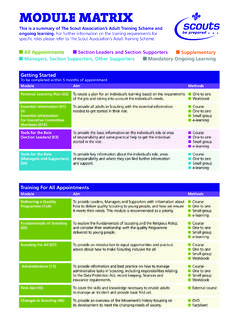Transcription of Understanding Healthcare Management
1 5/4/09 10:39 AM Page 17. C HAPTER. 2. Understanding Healthcare Management The prior chapter addressed growth in the health services industry and opportunities for Healthcare managers. By now the reader should appreci- ate that formal preparation in Healthcare Management can pay big divi- dends in terms of exciting Management jobs and positions with excellent career advancement. But just what do Healthcare managers do? And what are their roles and responsibilities? Healthcare Management is the profession that provides leadership and direction to organizations that deliver personal health services, and to divi- sions, departments, units, or services within those organizations.
2 This chapter gives a comprehensive overview of Healthcare Management as a profession. Understanding the roles, responsibilities, and functions carried out by Healthcare managers is important for those individuals considering the field to make informed decisions about the fit. This chapter provides a discussion of key Management roles, responsibilities, and functions, as well as Management positions at different levels within Healthcare organi- zations. In addition, descriptions of supervisory level, mid-level, and sen- ior Management positions within different organizations are provided. 17. Jones and Bartlett Publishers, LLC.
3 NOT FOR SALE OR DISTRIBUTION. 5/4/09 10:39 AM Page 18. 18 C HAPTER 2 U NDERSTANDING H EALTHCARE M ANAGEMENT. THE NEED FOR Management . AND THEIR PERSPECTIVE. Healthcare organizations are complex and dynamic. The nature of orga- nizations requires that managers provide leadership, as well as the supervi- sion and coordination of employees. Organizations were created to achieve goals that were beyond the capacity of any single individual. In Healthcare organizations, the scope and complexity of tasks carried out in provi- sion of services are so great that individual staff operating on their own couldn't get the job done. Moreover, the necessary tasks in producing serv- ices in Healthcare organizations require the coordination of many highly specialized disciplines that must work together seamlessly.
4 Managers are needed to make certain that organizational tasks are carried out in the best way possible to achieve organizational goals and that appropriate resources, including financial and human resources, are adequate to support the organization. Healthcare managers are appointed to positions of authority where they shape the organization by making important decisions. Such decisions, for example, relate to recruitment and development of staff, acquisition of technology, service additions and reductions, and allocation and spending of financial resources. Decisions made by Healthcare managers not only focus on ensuring that the patient receives the most appropriate, timely, and effective services possible, but also address achievement of perfor- mance targets that are desired by the manager.
5 Ultimately, decisions made by an individual manager affect the organization's overall performance. Managers must consider two domains as they carry out various tasks and make decisions (Thompson, 2007a). These domains are termed exter- nal and internal domains (see Table 2-1). The external domain refers to the influences, resources, and activities that exist outside the boundary of the organization but which significantly affect the organization. These fac- tors include community needs, population characteristics, and reimburse- ment from commercial insurers and Medicare and Medicaid. The internal domain refers to those areas of focus that managers need to address on a daily basis, such as ensuring the appropriate number and types of staff, financial performance, and quality of care.
6 These internal areas reflect the operation of the organization where the manager has the most control. Keeping the dual perspective requires significant balance on the part of Management and significant effort in order to make good decisions. Jones and Bartlett Publishers, LLC. NOT FOR SALE OR DISTRIBUTION. 5/4/09 10:39 AM Page 19. M ANAGEMENT: D EFINITION , F UNCTIONS , AND C OMPETENCIES 19. Table 2-1 Domains of Health Services Administration External Internal Community Demographics/Need Staffing Licensure Budgeting Accreditation Quality services Regulations Patient satisfaction Stakeholder Demands Physician relations Competitors Financial performance Medicare and Medicaid Technology acquisition Managed care organizations/Insurers New service development Source: Thompson, Health Services Administration in S.
7 Chisolm (Ed.), The Health Professions: Trends and Opportunities in Health Care, 2007. M A N A G E M E N T: D E F I N I T I O N , FUNCTIONS, AND COMPETENCIES. As discussed earlier, Management is needed to support and coordinate the services that are provided within Healthcare organizations. Management has been defined as the process, comprised of social and technical func- tions and activities, occurring within organizations for the purpose of accomplishing predetermined objectives through humans and other resources (Longest, Rakich, & Darr, 2000). Implicit in the definition is that managers work through and with other people, carrying out techni- cal and interpersonal activities, in order to achieve desired objectives of the organization.
8 Others have stated that a manager is anyone in the organi- zation who supports and is responsible for the work performance of one or more other persons (Lombardi & Schermerhorn, 2007). While most beginning students of Healthcare Management tend to focus on the role of the senior manager or lead administrator of an organization, it should be realized that Management occurs through many others who may not have manager in their position title. Examples of some of these managerial positions in Healthcare organizations include supervisor, coor- dinator, and director, among others (see Table 2-2). These levels of mana- gerial control are discussed in more detail in the next section.
9 Jones and Bartlett Publishers, LLC. NOT FOR SALE OR DISTRIBUTION. 5/4/09 10:39 AM Page 20. 20 C HAPTER 2 U NDERSTANDING H EALTHCARE M ANAGEMENT. Table 2-2 Managerial Positions, By Organizational Setting Organizational Setting Examples of Managerial Positions Physician Practice Practice Manager Director of Medical Records Supervisor, Billing Office Nursing Home Administrator Manager, Business Office Director, Food Services Admissions Coordinator Supervisor, Environmental Services Hospital Chief Executive Officer Vice President, Marketing Clinical Nurse Manager Director, Revenue Management Supervisor, Maintenance Managers implement six Management functions as they carry out the process of Management (Longest, Rakich, & Darr, 2000): Planning.
10 This function requires the manager to set a direction and determine what needs to be accomplished. It means setting priorities and determining performance targets. Organizing: This Management function refers to the overall design of the organization or the specific division, unit, or service for which the manager is responsible. Further, it means designating reporting rela- tionships and intentional patterns of interaction. Determining posi- tions, teamwork assignments, and distribution of authority and responsibility are critical components of this function. Staffing: This function refers to acquiring and retaining human resources.
















